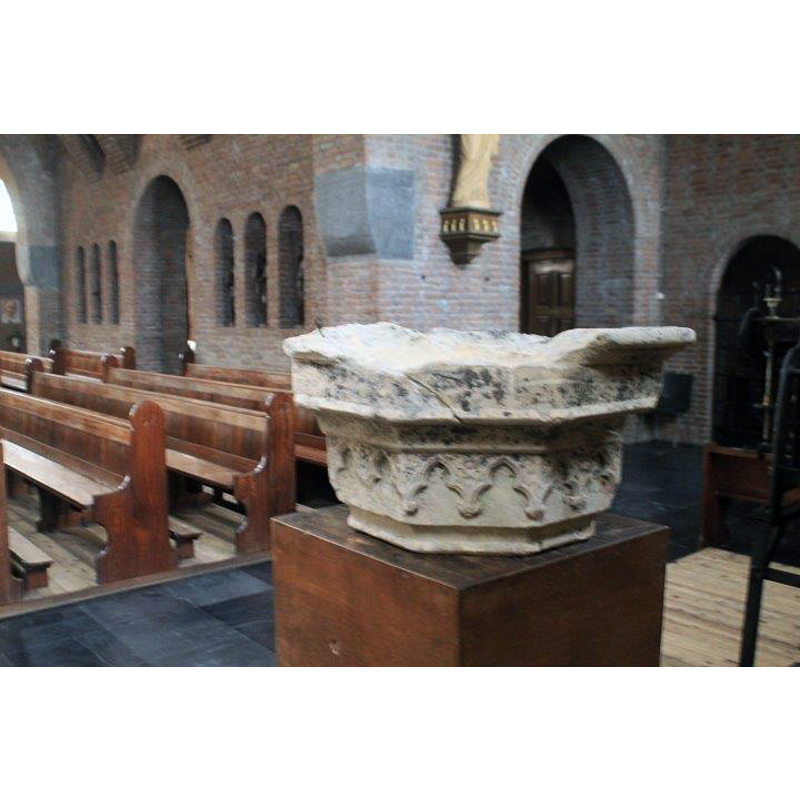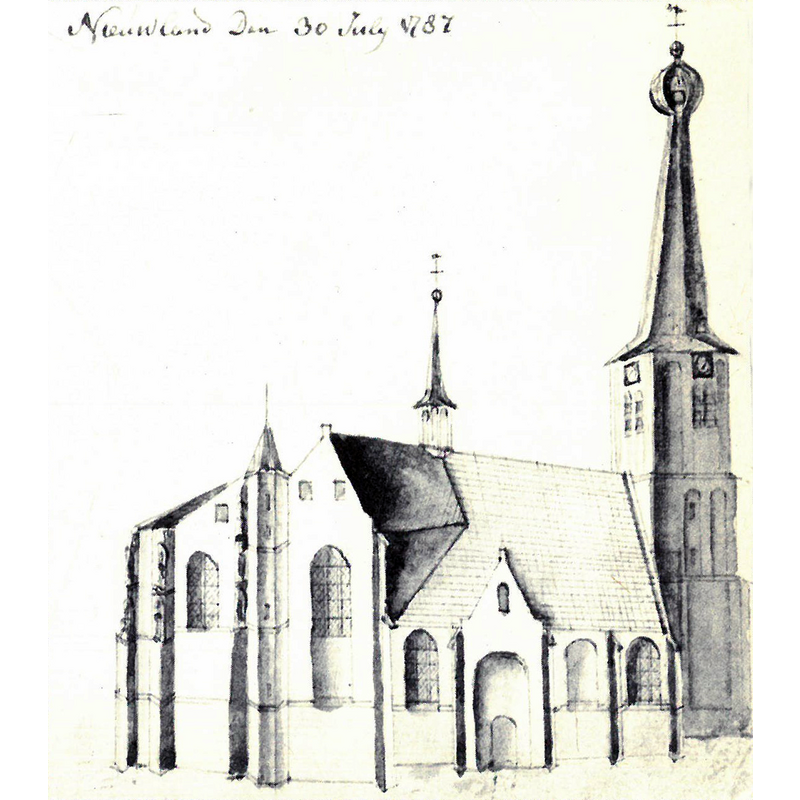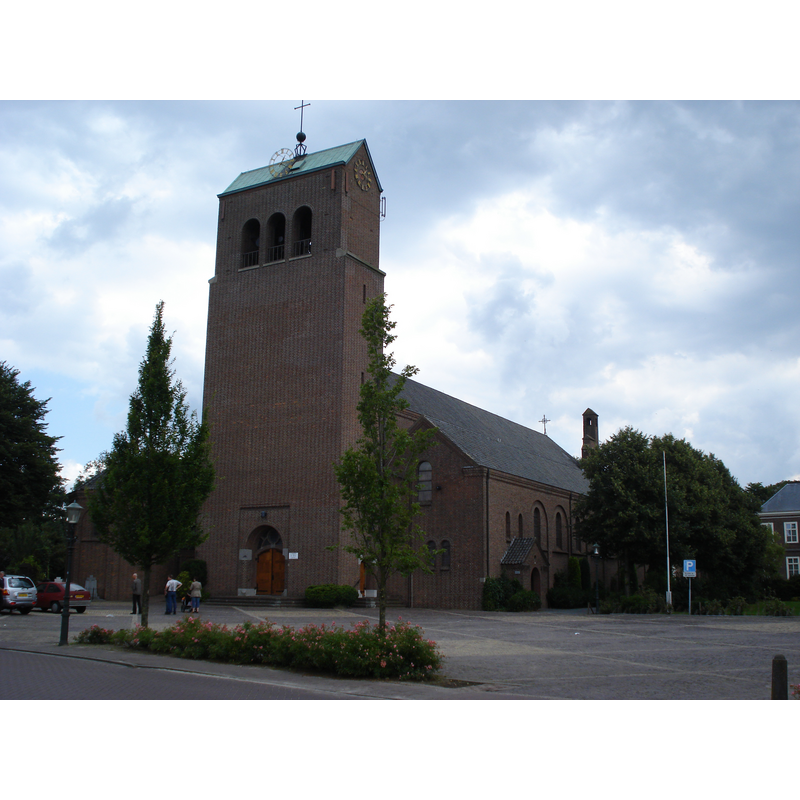Nuland / Nieuwland

Image copyright © Herman Roelofs, 2016
Image and permission received (e-mail from Joost Limburg, 27 May 2016)
Results: 3 records
view of church exterior
Scene Description: artist's rendering of the old 'poldkerk' dated 30 July 1787; the building was demolished in 1857
Copyright Statement: Image copyright © Bossche Encyclopedie, 2016
Image Source: 30 July 1787 drawing in the Bossche Encyclopedie [www.bossche-encyclopedie.nl/overig/kerken/img/polderkerk (nuland) (02).org.jpg] [accessed 13 January 2016]
Copyright Instructions: No known copyright restriction / Fair Dealing
view of church exterior - southwest view
view of font in context
INFORMATION
FontID: 20301NUL
Object Type: Baptismal Font1 (fragment)
Church/Chapel: Rooms-Katholieke Parochiekerk Sint-Jan's Onthoofding
Church Patron Saints: St. John the Baptist [the beheading of]
Church Location: [new church: Kerkstraat 30, Nuland, Netherlands]
Country Name: Netherlands
Location: Noord-Brabant
Directions to Site: Located off (N) the A59 [aka Rijksweg-Zuid], about 10 km E of 's-Hertogenbosch
Font Location in Church: [cf. FontNotes]
Century and Period: 15th century [fragment], Late Medieval [composite]
Credit and Acknowledgements: We are grateful to Joost Limburg for his help in documenting this font, to Herman Roelofs, of the Parish Church Council at Nuland, for his photograph of the present font, and to Pol Herman for his help in documenting the disappeared font
Church Notes: original church probably 13thC, first documented 14thC; demolished 1857; only excavated foundations remain
Font Notes:
Click to view
Hermans (1855) writes of his visit to the old 'polderkerk' in Nuland in 1847, a building he describes as "merkewaardige" [=remarkable]; in it Hermans reports finding fragments of a broken baptismal font in a corner; he describes the finding as a remarkable relic of the 11th century which he tried to acquire for the historical society he belonged to, the Provinciaal Gennotschap, but the issues of ownership of the contents of the church made him give up. Hermans (ibid.) does, however, mention that the pastor appeared to appreciate the value of the object and Hermans accepted that it would be preserved. [NB: we have not found any other sources on this object, nor of its present whereabouts]. [NB: in a 27 May 2016 e-mail to BSI Joost Limburg wrote: "In his article in the Dietsche Warande of 1855, C.R. Hermans also describes a font in Nuland (apart from the ones in Herpen, Deursen and more). He writes that when he visited the church in 1847, a couple of years after it had been bought back from the Protestants by the Catholics, he saw an old stone font from the 11th century lying in pieces in a remote corner. He would have bought it for the Provinciaal Genootschap, however at that time the ownership of the church and what belonged to it was being disputed. But he learned that the priest also was interested in this religious antiquity, so Hermans trusted that he would keep it. The old church was in bad repair and also the area where it stood was frequently flooded, so in 1859 a new church was built. The old one was then demolished. The new church in its turn was largely demolished by the Germans in 1943. Shortly after the war yet another church was built. It seems almost impossible that the old font could have survived all this, and indeed, when I asked, the church warden sent me a photo of what currently is being used as a font (attached). He wrote they know it's from the previous church, and maybe even from the oldest one. But I don't think that this is what Hermans saw, do you? I'm not even sure what it is, an old stoup, gothic? A capital converted into a stoup or font? Apparently the article in the Dietsche Warande was new to the warden. Anyhow, what Hermans saw, since he dates it 11thC, must have looked like the fonts in Herpen or Deursen. And most likely, I suppose, that font is missing or even lost."] The object used as a font in May 2016 [cf. Images area] consists of a stone basin that appears to be a fragment of a font or stoup; it is octagonal in shape, with a very pronounced lip moulding, most of it damaged and broken off; band of trefoil decoration around the lower sides; raised on a wooden pedestal.
A communication from Pol Herman to BSI (e-mail of 19 March 2022) adds some additional sources and comments: 1) Source : Dietsche Warande Jaargang 1 (1855), Vlugtige blikken in de kerkelijke archaeologie van Noordbrabant. In 1847 I visited the remarkable Church in Nuland because of its architectural style, which the Protestants sold to the Catholics a few years ago. Going round the church, I found a stone baptismal font in pieces in a lost corner. Needless to say, I did my best to save this curious relic of the XIth century from destruction. I would gladly have bought it for the collection of the Provincial Society, but there was a dispute about the property of the church and what belongs to it. I was pleased to learn that the Vicar is very fond of this ecclesiastical antiquity, so that it will be preserved. 2) Source : GESCHIEDENIS VAN NOORDBRABANT Door Peter Norbertus Panken te Bergeik, vernieuwd en gerangschikt, 1898, Stichting Cultureel Brabant (CuBra), gedigitaliseerd door Johan Biemans.
In the ancient and artistic church, demolished in 1857, I saw in 1844 in a corner of the then unused temple, the stone baptismal font lying in pieces. 3) a communication in Dutch from Jean-Claude Ghislain to Pol Herman (e-mail of 31 December 2020) [English version kindly provided by Pol Herman to BSI: "The article you refer to is known to us. It is indeed a description of the former polder church, demolished in the 1950s, after it had been structurally neglected under Protestant leadership. Nothing more has been heard of the baptismal font referred to in the article. It wouldn't surprise me that the 11th century baptismal font, like many other remnants of the old church, were smashed to rubble during demolition and used to pave the road that was then called Klepelstraat. After demolition, the parish donated an enormous mountain of rubble to the municipality, which the municipality used for road surfacing. The pastor of that time (Pollet) should therefore have appreciated a little more “on this ecclesiastical antiquity [...] information taken in 2007 from the parish, they do not know anything about an old Romanesque font".
COORDINATES
Church Latitude & Longitude Decimal: 51.730861, 5.433242
Church Latitude & Longitude DMS: 51° 43′ 51.1″ N, 5° 25′ 59.67″ E
UTM: 31U 668032 5733907
MEDIUM AND MEASUREMENTS
Material: stone, sandstone
Font Shape: octagonal (mounted)
Basin Interior Shape: round
Basin Exterior Shape: octagonal
REFERENCES
Hermans, C.R., "Vlugtige blikken in de kerkelijke archaeologie van Noordbrabant", Jaargang 1, De Dietsche Warande, 1855, pp. 180-201; p. 193

